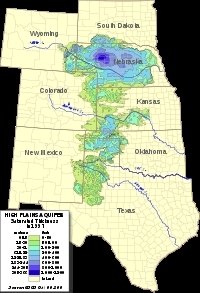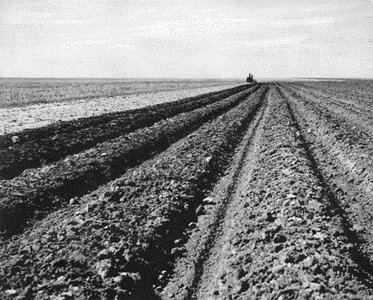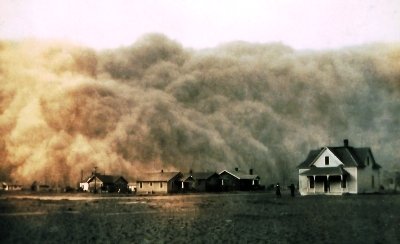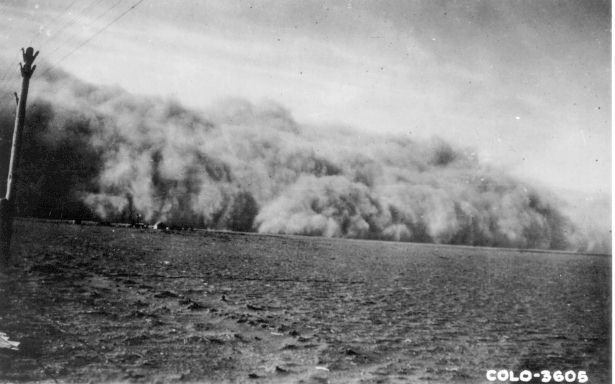





On November 11, 1933, the first giant dust storm, dubbed "The Great Black Blizzard," hit the Great Plains. What caused this phenomenon and the increasingly frequent dust storms of the 1930s in the United States? Were they preventable, predictable, man-made, or flukes of nature? A look at United States history from a gardener's perspective can shed some interesting light. (NB: this is NOT your U.S. history class from high school!)
A Brown Desert?
In the latter parts of the nineteenth century, especially the 1860s and 1870s, the middle part of the North American continent was considered to be a "Brown Desert." Land stretched for hundreds of miles from the great Mississippi River to the mighty Rocky Mountains with no reliable sources of water. Settlers went north to Oregon and Washington but were afraid to try their hands at farming the Great Plains of Oklahoma, Arkansas, Missouri, Iowa, Nebraska, Kansas, Texas, Colorado and New Mexico. Abraham Lincoln signed the Homestead Act into law (the same day as he signed the Emancipation Proclamation) in 1862.
Stormy Weather
 Then reports came back from settlers following the Oregon Trail that the Brown Desert had become green! An extended period of drought had been replaced by a temporary period of raininess. New territories were opened up for settlement and land was virtually given away by the U.S. government. Eager settlers poured past the Mississippi into areas that had never ever been farmed. It was erroneously believed that plowing caused rain. Of course, it was later learned that the topsoil was anchored by tall drought-tolerant prairie grasses with deep roots (see these related Dave's Garden articles) which could reach the Ogalalla Aquifer below in times of little rain. This topsoil, by virtue of being virgin land, had a certain intrinsic fertility. However, once that was used, it was simply a layer of dust with no connection to the aquifer deep beneath, which had watered the prairie in past dry periods.
Then reports came back from settlers following the Oregon Trail that the Brown Desert had become green! An extended period of drought had been replaced by a temporary period of raininess. New territories were opened up for settlement and land was virtually given away by the U.S. government. Eager settlers poured past the Mississippi into areas that had never ever been farmed. It was erroneously believed that plowing caused rain. Of course, it was later learned that the topsoil was anchored by tall drought-tolerant prairie grasses with deep roots (see these related Dave's Garden articles) which could reach the Ogalalla Aquifer below in times of little rain. This topsoil, by virtue of being virgin land, had a certain intrinsic fertility. However, once that was used, it was simply a layer of dust with no connection to the aquifer deep beneath, which had watered the prairie in past dry periods.
Over-farming
The stage was set. Thousands of acres of uncultivated, never-before farmed land. An uncharacteristically rainy period, giving rise to new fertility on the Great American Desert. And thousands of settlers from all over the world eager to farm their 160 acres and build their houses. One more factor soon entered the equation: as the 20th century progressed, hostilities broke out in Europe, sending the price of wheat higher than ever before. This was just one more incentive to plant more wheat than ever!
was just one more incentive to plant more wheat than ever!
In Kansas, says the State History Timeline of Kansas, "the previously uncultivated land (thousands of acres), planted to supply warring nations of Europe during World War I, was allowed to lay fallow during the recession of the 1920s, and became part of the "dust bowl" of the 1930s." Similar situations were happening all over the Great Plains. If not left fallow, yields from the land were dropping precipitously. And in the 1930s, the rainy period was replaced by a windy extended drought. (Or maybe the unusual rainy period had reverted to its normal hot, windy and dry.)
Hot and Windy
The deep-rooted perennial prairie grasses had been replaced by annual crops like wheat, planted in long, long straight rows. When the winds came, they blew straight along the rows, taking the dry dusty top layer with them, and building up into dust storms. There were 14 dust storms reported in 1932 and 38 in 1933. The first of the giant dust storms happened on Armistice Day, 1933, November 11. The sunlight was obliterated for the day, leaving a darkness blacker than night. Drifts of dust as deep as 6 feet high obscured vehicles and sheds. This so-called "Great Black Blizzard" occured in South Dakota. Dust blew all the way to Chicago and there were red snow storms in New England that year! This event destroyed farms all the way from the Texas panhandle up to Canada.
Black Sunday
The dust storm of April 14, 1935, was referred to as "Black Sunday." An Associated Press reporter described the area as a "Dust Bowl" and the term was quickly adopted by the media and politicians to refer to the affected areas. One-quarter of the population of the Great Plains abandoned their farms for dreams of a successful life  further west or on the road, making the 1930s the largest migration of people in the shortest period of time that has ever taken place in the United States. However, fans of Steinbeck's The Grapes of Wrath may be surprised to learn that of the 2.5 million people leaving their homes and farms in Oklahoma, Arkansas, Missouri, Iowa, Nebraska, Kansas, Texas, Colorado and New Mexico, only 250,000 wound up in California. And the remaining residents somehow eked out a meager existence in their dust-ravaged farms.
further west or on the road, making the 1930s the largest migration of people in the shortest period of time that has ever taken place in the United States. However, fans of Steinbeck's The Grapes of Wrath may be surprised to learn that of the 2.5 million people leaving their homes and farms in Oklahoma, Arkansas, Missouri, Iowa, Nebraska, Kansas, Texas, Colorado and New Mexico, only 250,000 wound up in California. And the remaining residents somehow eked out a meager existence in their dust-ravaged farms.
Dirty Thirties
As folksinger Woody Guthrie, whose songs reflected the woes and situations of the people of the 1930s, said in So Long, It's Been Good To Know You, "this dusty old dust is a getting my home and I got to be drifting along." In fact, this dusty old dust caused inhalation pneumonia in both people and livestock. It clogged the engines of farm machinery and stranded schoolchildren. Farmers would stuff every crack of their homes with wet rags in a vain attempt to keep the dust out of their houses. Often they would run ropes between the outbuildings in case they got caught outside when a storm came. As Mildred Opitz of Nebraska says of the dust, it was, "on the floors and everything else. But it passed, and we lived through it. And I'm here to talk about it."..
The President's Report
A Report of the Great Plains Drought Committee of August 1936, for President Franklin Roosevelt said, among other things, the Plains should "arrest the wastage of soil by erosion and make efficient use of the water resources of the region." The Committee proposed planting trees as wind breaks, and that farmers plant crops in ways that follow the contours of the land instead of always in a straight line. Strip cropping, where tall crops are interspersed in rows with shorter ones, was also recommended. And the committee suggested that "sub-marginal land" be removed from private ownership and be bought up by the government, to be preserved as natural grasslands. The report recommended developing suitable grasses to replant in eroded areas. Farms that were still arable should implement soil- and water-conserving practices.
Putting Water Conservation Into Practice
The stubborn folks who stayed behind or moved elswhere (other than to California) mostly survived as long as they stuck it out. One report suggests that younger people were more likely to move and older ones more likely to stay put. After the critical drought of the 1930s had passed, land was cheaper and people were able to acquire larger farms than they had before. But farmers were reluctant to change their farming practices, even though they weren't really working. Ultimately the federal government had to pay farmers $1 an acre to get them to implement the new ideas. But finally the Dust  Bowl regions started to recover. A less severe drought in the 1950s was weathered less painfully.
Bowl regions started to recover. A less severe drought in the 1950s was weathered less painfully.
Dust Bowls Around the World
At least one research team feels that the U.S. Great Plains are not suitable for farming in ANY way and are due for another Dust Bowl. They suggest that the entire region be renamed Buffalo Commons and be replanted with suitable native grasses. Agricultural scientists are studying conditions in India and China. Apparently situations there are very close to the Dust Bowl conditions of the 1930s in the USA.
All photos are in the Public Domain.
If you are interested in more accounts of the 1930s Dust Bowl, try these links:
Wessels Living History Farm
What Was the Dust Bowl?
My cactus is shriveled and black at the bottom
Organic Gardening And Farming: The Benefits
Pegasus Agriculture And Its Green Farming Techniques To Cut Down Carbon Footprint
Strange And Bizarre Flowers: Black Sheep Of The Plant Family
Gardening Techniques Across The UK
10 Essential Native Perennials for the Great Lakes and Upper Midwest
Copyright © www.100flowers.win Botanic Garden All Rights Reserved